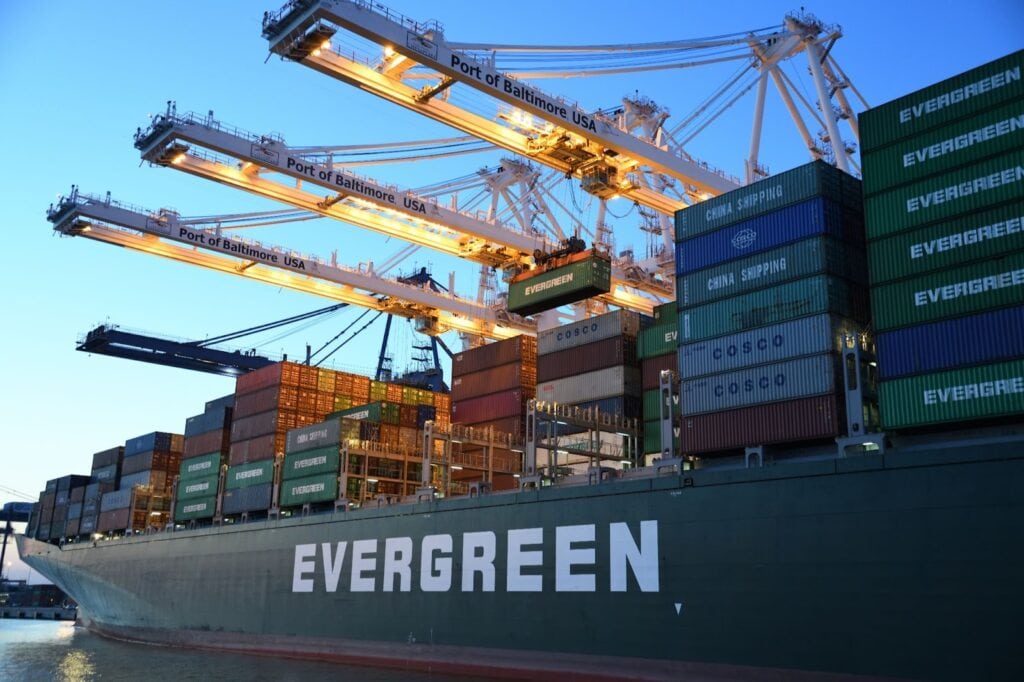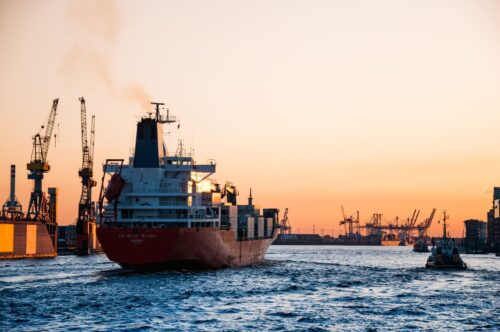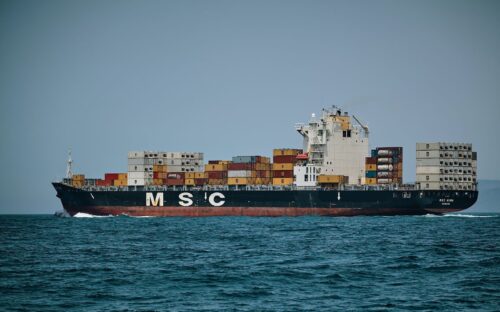Post Panamax Ships: Design, Evolution, and Future

Container shipping plays a pivotal role in the ever-evolving global trade landscape, with ships of various sizes and capacities serving distinct purposes in the supply chain. One class of vessels that has significantly transformed maritime transportation is the Post-Panamax ships.
These ships, surpassing the size constraints of the Panama Canal, are instrumental in cargo transportation in large quantities, facilitating the growth of global trade.
In this article, we’ll dive into Post-Panamax ships, shedding light on their design, history, size, cargo capacity, shipping routes, and critical role in the marine industry.
Post Panamax Ships By Design
Post-Panamax ships are a class of vessels that exceed the maximum size parameters set by the Panama Canal’s original locks, making them too large to transit through the canal.
The term “Post Panamax” emerged following the expansion of the Panama Canal in 2016, with the creation of new locks to accommodate larger ships.
These vessels, designed with larger dimensions and higher cargo capacity, are essential in meeting the increasing demands of global commerce.
History and Origin
The origin of Post-Panamax ships dates back to the early 1980s, with the advent of larger ships that exceeded the size restrictions of the Panama Canal. The Canal, completed in 1914, was a significant maritime route connecting the Atlantic and Pacific Oceans.
However, the Canal’s size limitations, known as “Panamax” dimensions, restricted the size of vessels that could transit through it.
With the expansion of the global economy and the surge in international trade, the demand for larger ships grew. Shipping lines began commissioning larger vessels that could carry more cargo, leading to the birth of Post-Panamax ships.
The evolution of these vessels was further propelled by the expansion of the Panama Canal in 2016, which introduced larger locks, known as “Neo Panamax” or “New Panamax,” capable of accommodating these bigger vessels.
Size and Capacity
Post-Panamax ships are larger than Panamax vessels in all dimensions – length, breadth (beam), and depth. They typically have a length of over 294.13 meters (965 feet), a beam exceeding 32.31 meters (106 feet), and a draught beyond 12.04 meters (39.5 feet).
These ships are designed to carry 5,000 to 14,000 Twenty-Foot Equivalent Units (TEUs) of cargo, making them ideal for high-volume, long-haul routes.
Cargo and Shipping Routes
Post-Panamax ships are primarily container ships designed to transport various goods packed in standard-sized containers. They play a crucial role in transporting electronics, consumer goods, machinery, and other high-value items across the globe.
These ships operate on major sea routes, connecting continents and facilitating global trade. The primary shipping routes for Post-Panamax vessels include trans-Pacific routes, connecting Asia with the West Coast of the United States, and trans-Atlantic routes, connecting Europe with the East Coast of the United States.
Crew and Technology
Post-Panamax ships employ advanced technology for navigation, cargo handling, and ship operations. This includes state-of-the-art radar systems, electronic chart display and information systems (ECDIS), and automated cargo handling equipment.
These vessels typically have a multinational crew of officers and ratings responsible for navigation, cargo operations, engineering, and other aspects of ship operation.
Post Panamax Speed
The speed of a Post Panamax ship varies based on its design, load, and operational requirements. Typically, these vessels sail at an average speed of around 23 to 25 knots.
However, they can achieve higher speeds if required, making them versatile and efficient transportation mediums.
Significance of Post-Panamax Ships
The significance of Post-Panamax ships in today’s shipping industry cannot be understated. They have been instrumental in meeting the increasing demands of global trade, offering high cargo capacity and operating efficiency.
The advent of Post Panamax vessels also led to developments in port facilities worldwide, including the deepening of harbors, upgrading of container terminals, and installation of larger cranes capable of handling these vessels.
Panamax Evolution

The evolution of Panamax ships has been fascinating, marked by the steady increase in size and capacity to meet the rising demands of global trade.
The journey can be traced from the original Panamax ships, designed to transit through the Panama Canal’s original locks, to the behemoths of today’s shipping industry, the Ultra Large Container Vessels (ULCVs). Here is a brief outline of this evolution:
- Panamax: These were the maximum-sized vessels, both in terms of dimensions and displacement, that could pass through the original locks of the Panama Canal.
- Post-Panamax I & II: These categories were introduced after ships larger than the Panamax specifications emerged. They represented the first generation of vessels too large to pass through the Panama Canal.
- New Panamax: The term emerged after the Panama Canal expansion project was completed in 2016. It represented the maximum size of vessels that could transit the Canal’s new locks.
- Neo Panamax: A term used to describe ships slightly larger than the New Panamax vessels but still capable of transiting the Canal’s new locks under certain conditions.
- Very Large Container Ships (VLCS): This category represents larger vessels with a capacity ranging from 10,000 to 14,500 TEUs.
- Ultra Large Container Ships (ULCVs): These are the largest vessels currently in service, with a capacity exceeding 14,500 TEUs.
Post Panamax I and II
Post-Panamax I vessels were the first generation of ships that exceeded the original Panamax dimensions. Their emergence marked a turning point in the shipping industry, as they were designed to carry more cargo to meet the increasing demands of global trade.
Post-Panamax II vessels were an upgrade to the first generation, offering even larger dimensions and cargo capacity, but still needed help to transit through the original Panama Canal locks.
New-Panamax
The New Panamax ships are vessels designed to fit the expanded Panama Canal locks. They can carry up to 13,000 TEUs, nearly three times the capacity of the original Panamax ships, thus offering greater operational efficiency.
Neo-Panamax
Neo Panamax vessels are a category of ships slightly larger than the New Panamax specifications. They can transit the new locks of the Panama Canal under certain conditions, offering greater flexibility for shipping lines.
Very Large Containership (VLCS)
Very Large Container Ships (VLCS) can carry 10,000 to 14,500 TEUs. They represent a significant leap in ship size and cargo capacity, facilitating large-scale, long-haul transportation of goods.
Ultra Large Containership (ULCV)
Ultra Large Container Vessels (ULCVs) are currently the largest vessels in service, with a capacity exceeding 14,500 TEUs. These mega-ships have reshaped global shipping dynamics, offering unmatched economies of scale for high-volume routes.
The Future of Post-Panamax Ships

The future of Post-Panamax ships holds exciting possibilities, with advancements in technology and efficiency further pushing the limits of their design and capacity. With the ongoing trend of ‘bigger is better,’ we can expect the emergence of even larger and more efficient vessels in the shipping industry.
The Panama Canal and Panamax Ships
The Panama Canal continues to play a pivotal role in shaping the dimensions and design of many cargo ships. With future expansions and deepening projects, it will continue influencing the evolution of Panamax and Post-Panamax vessels.
FAQs
Here are some of the most commonly asked questions about Post-Panamax ships.
How big is a Post-Panamax ship?
Post-Panamax ships typically have a width of over 32.31 meters, exceeding the width restrictions of the original Panama Canal locks.
What is the difference between Post-Panamax and New Panamax?
Post-Panamax ships are larger than the original Panama Canal’s size limit, while New Panamax ships fit the canal’s expanded lock dimensions.
What is post-Suezmax?
Post-Suezmax refers to ships larger than the maximum size that can transit the Suez Canal.
What are Panamax-type vessels?
Panamax-type vessels are ships designed to fit the size restrictions of the original Panama Canal locks.
Final Thoughts
To sum up, Post-Panamax ships have transformed global trade by enabling the transportation of larger quantities of cargo more efficiently. As these larger vessels continue to sail across the Panama Canal and other ports worldwide, they underscore the indomitable progress of maritime transportation and the interconnectedness of our global economy.
